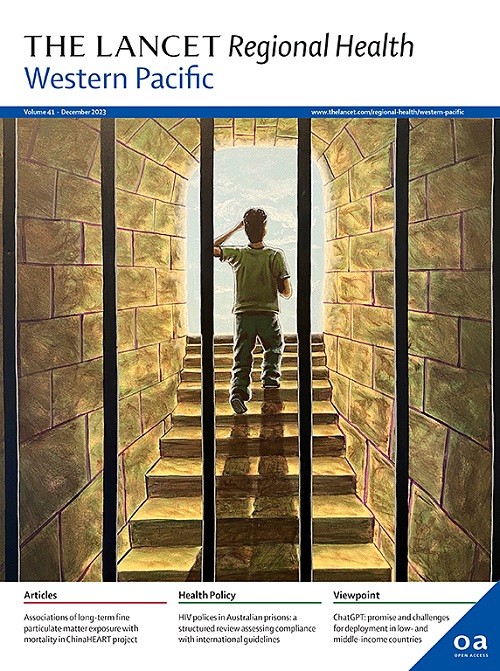人工智能辅助海绵细胞学筛查食管鳞状细胞癌和食管胃交界腺癌的可接受性和准确性:一项多中心队列研究
IF 7.6
1区 医学
Q1 HEALTH CARE SCIENCES & SERVICES
引用次数: 0
摘要
食管鳞癌(ESCC)和食管胃交界腺癌(AEJ)在中国面临着重大的健康挑战,通常在晚期诊断,预后较差。筛查是减轻高危地区ESCC和AEJ负担的关键策略。尽管内窥镜已被证明在高患病率地区对两种癌症的早期检测是有效的,但其侵入性和资源密集性使其无法进行大规模筛查。因此,迫切需要开发一种侵入性小、易于获取、诊断准确性好的方法,在内镜检查前识别高危人群。我们的目的是评估人工智能(AI)辅助海绵细胞学检测在中国高风险地区使用一种新型细胞收集设备筛查ESCC和AEJ的可接受性和准确性。方法在ESCC和AEJ的5个高危区招募年龄在50岁及以上的参与者。采用新型微创胶囊海绵采集食管及食管胃交界细胞,经训练的人工智能系统扫描细胞学切片。报告定性结果(指示异常细胞的位置)和定量结果(扫描细胞总数、潜在异常细胞计数和105个细胞学特征)。参与者在程序完成后立即对可接受性进行评分,范围从0(最低)到10(最可接受)。随后进行内窥镜检查并根据需要进行活检。采用Boruta算法进行特征选择。建立Lasso logistic回归模型预测高级别病变(ESCC、AEJ和高级别上皮内瘤变)的复合预后,以细胞学特征和流行病学特征作为预测特征。模型性能主要是用接收机工作特性曲线下面积(AUC)来衡量的。使用1000-bootstrap样本对预测模型进行内部验证。共有1852名参与者参与并完成了研究程序。细胞采集过程中未发生严重不良事件,可接受评分分别为10分(72.1%)、9分(19.8%)、8分(3.8%)、7分(1.5%)和6分(0.9%)。30例(1.6%)参与者经内镜活检确诊为高级别病变。lasso logistic模型检测高级别病变的AUC为0.902 (95%CI: 0.851, 0.952),优于细胞学诊断和单独使用异常细胞计数。采用bootstrap分析对模型进行内部验证,模型的平均AUC为0.9 (95%CI: 0.845, 0.944)。我们证明了人工智能辅助海绵细胞学在高风险地区的安全性和可接受性,在检测ESCC, AEJ及其前体病变方面具有很高的准确性。我们的结果为创新的病因学和早期检测研究铺平了道路。本文章由计算机程序翻译,如有差异,请以英文原文为准。
Acceptability and accuracy of artificial intelligence–assisted sponge cytology for screening of esophageal squamous cell carcinoma and adenocarcinoma of the esophagogastric junction: a multi-center cohort study
Background
Esophageal squamous cell carcinoma (ESCC) and adenocarcinoma of the esophagogastric junction (AEJ) present significant health challenges in China, often diagnosed at advanced stages with poor prognoses. Screening is the pivotal strategy to relieve the burden of ESCC and AEJ in high-risk areas. Even though endoscopy has proven effective in the early detection of both cancers in high-prevalence regions, its invasiveness and resource-intensiveness make it impractical for large-scale screening. Therefore, developing a less invasive and readily accessible method with good diagnostic accuracy to identify high-risk individuals before endoscopy is urgently needed. We aim to evaluate the acceptability and accuracy of artificial intelligence (AI)-assisted sponge cytology tests using a novel cell collection device for ESCC and AEJ screening in Chinese high-risk regions.
Methods
Participants aged 50 years or older were recruited in five high-risk regions of ESCC and AEJ. Cells from esophagus and esophagogastric junction were collected using a novel and minimally invasive capsule sponge, and cytology slides were scanned by a trained AI system. The qualitative outcomes (indicating the location of abnormal cells) and quantitative outcomes (counts of total scanned cells, potentially abnormal cells and 105 cytological features) were reported. Participants scored acceptability immediately following the procedure on a scale of 0 (least) to 10 (most acceptable). Endoscopy was performed subsequently with biopsy as needed. Feature selection was performed using Boruta algorithm. Lasso logistic regression model was developed to predict a composite outcome of high-grade lesions (ESCC, AEJ and high-grade intraepithelial neoplasia), with cytological features and epidemiological features as the predictive features. Model performance was primarily measured with the area under the receiver operating characteristic curve (AUC). Internal validation of the prediction models was performed using the 1000-bootstrap resample.
Findings
A total of 1852 participants were enrolled and completed the study procedure. No serious adverse events were documented during the cell collection process, and acceptability scores were 10 (72.1%), 9 (19.8%), 8 (3.8%), 7 (1.5%) and 6 (0.9%). 30 (1.6%) participants were diagnosed with high-grade lesions confirmed by endoscopic biopsy. The lasso logistic model achieved an AUC of 0.902 (95%CI: 0.851, 0.952) for detecting high-grade lesions, outperforming that of the cytological diagnosis and the sole use of abnormal cell counts. Internal validation of the model by bootstrap analysis was used, and the mean AUC of the model was 0.9 (95%CI: 0.845, 0.944).
Interpretation
We demonstrate the safety and acceptability of AI-assisted sponge cytology in high-risk regions, with high accuracy for detecting ESCC, AEJ and their precursor lesions. Our results pave the way for innovative etiology and early-detection research.
求助全文
通过发布文献求助,成功后即可免费获取论文全文。
去求助
来源期刊

The Lancet Regional Health: Western Pacific
Medicine-Pediatrics, Perinatology and Child Health
CiteScore
8.80
自引率
2.80%
发文量
305
审稿时长
11 weeks
期刊介绍:
The Lancet Regional Health – Western Pacific, a gold open access journal, is an integral part of The Lancet's global initiative advocating for healthcare quality and access worldwide. It aims to advance clinical practice and health policy in the Western Pacific region, contributing to enhanced health outcomes. The journal publishes high-quality original research shedding light on clinical practice and health policy in the region. It also includes reviews, commentaries, and opinion pieces covering diverse regional health topics, such as infectious diseases, non-communicable diseases, child and adolescent health, maternal and reproductive health, aging health, mental health, the health workforce and systems, and health policy.
 求助内容:
求助内容: 应助结果提醒方式:
应助结果提醒方式:


